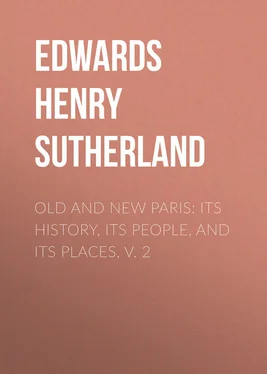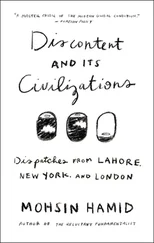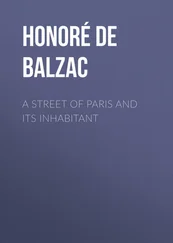Henry Edwards - Old and New Paris - Its History, Its People, and Its Places, v. 2
Здесь есть возможность читать онлайн «Henry Edwards - Old and New Paris - Its History, Its People, and Its Places, v. 2» — ознакомительный отрывок электронной книги совершенно бесплатно, а после прочтения отрывка купить полную версию. В некоторых случаях можно слушать аудио, скачать через торрент в формате fb2 и присутствует краткое содержание. Жанр: foreign_antique, foreign_prose, Путешествия и география, на английском языке. Описание произведения, (предисловие) а так же отзывы посетителей доступны на портале библиотеки ЛибКат.
- Название:Old and New Paris: Its History, Its People, and Its Places, v. 2
- Автор:
- Жанр:
- Год:неизвестен
- ISBN:нет данных
- Рейтинг книги:4 / 5. Голосов: 1
-
Избранное:Добавить в избранное
- Отзывы:
-
Ваша оценка:
- 80
- 1
- 2
- 3
- 4
- 5
Old and New Paris: Its History, Its People, and Its Places, v. 2: краткое содержание, описание и аннотация
Предлагаем к чтению аннотацию, описание, краткое содержание или предисловие (зависит от того, что написал сам автор книги «Old and New Paris: Its History, Its People, and Its Places, v. 2»). Если вы не нашли необходимую информацию о книге — напишите в комментариях, мы постараемся отыскать её.
Old and New Paris: Its History, Its People, and Its Places, v. 2 — читать онлайн ознакомительный отрывок
Ниже представлен текст книги, разбитый по страницам. Система сохранения места последней прочитанной страницы, позволяет с удобством читать онлайн бесплатно книгу «Old and New Paris: Its History, Its People, and Its Places, v. 2», без необходимости каждый раз заново искать на чём Вы остановились. Поставьте закладку, и сможете в любой момент перейти на страницу, на которой закончили чтение.
Интервал:
Закладка:
The Workmen’s Club of Sainte-Geneviève is not the only one of the kind in Paris; there are at least ten formed on the same plan and which reach directly and surely, without any attempt at noisy propagandism, their essential aim: that of depriving the dram shop and the tavern of their prey.
The lower part of the Rue des Carmes leads to the market of the same name and to the Place Maubert, which occupies the site of the ancient convent. The cloister of the Couvent des Carmes was remarkable as a masterpiece of architecture.
The Place Maubert was in the middle ages the true forum of the University Quarter, the meeting place of the students, the boatmen of the Seine, and market people from all parts of the country, as well as the central academy of the language spoken by the populace. Thus it was said of a man who was coarse in his talk that he had “learned his compliments in the Place Maubert.” The “Compliments of the Place Maubert” was indeed the title of a dictionary of plebeianisms. The name of the place or square is corrupted from that of Jean Aubert, second Abbé of Sainte-Geneviève. Receiving from all sides the outpourings of six popular streets, the Place Maubert has witnessed many tumultuous scenes. Here in 1418 assembled the partisans of Bourgogne who set out to massacre the partisans of Armagnac in their prisons. Here were burnt as heretics Alexandre d’Evreux and Jean Pointer in 1533; the mason Poille in 1535, the goldsmith Claude Lepeintre in 1540, and finally, in 1546, the printer Étienne Dolet, who, by his religious and political opinions as well as by the bitterness of his polemical writings, had made for himself implacable enemies. Across the Place Maubert was dragged the body of Ramus, assassinated in 1572 at the College of Presles in the Rue des Carmes. On one side of it were raised in 1588 the first barracks of the partisans of the House of Guise against King Henri III., and sixty years later the barricades of the Fronde.
At a few steps from the Place Maubert stood, at the beginning of the eighteenth century, in the Rue de Bièvre and the Rue des Grands Degrés, two attorneys’ offices, where were engaged two young clerks destined one day to dazzle the world of letters and of the stage. One was Crébillon; the other Voltaire.
All kinds of famous houses existed on or in the immediate neighbourhood of the Place Maubert: that, for instance, of Grandjean, the celebrated surgeon and oculist to Louis XVI., and that of Marie Antoinette. Local tradition assigns one of the houses to Gabrielle d’Estrées – “la belle Gabrielle” of Henri IV., and here she may really have lived, though the hostile critics of the tradition point out that the architecture of the house does not take us further back than the reign of Louis XV. Part of the house in question is now let out in artisans’ lodgings. On the ground floor, painted red, is the Château Rouge, called also – it must be feared with more than external significance – the Guillotine. A special chapter is devoted to the Château Rouge by M. Macé, in his volume on the police of Paris. It is composed of two large rooms, which are filled from morning till night with the disreputable and dangerous classes; close by is a lodging-house, constructed in the garden of the ancient mansion, and let out entirely to Swiss workmen, who live together in the most economical manner, and pass the gaping mouth of the Château Rouge ten times a day without ever going in. It was at the tavern of the Château Rouge that, in 1887, three men proposed, accepted, and carried out among themselves a bet to throw a woman into the Seine simply for amusement. The victim was a drunken rag-picker, and the stake was two sous: the price of a small glass of brandy.
In the immediate neighbourhood of the University and the Sorbonne, in the very heart of the district of the schools, are two of the most ancient and interesting buildings in Paris: the Palais des Thermes, which carries us back to the Lutetia of the Romans, and the Hôtel Cluny, which recalls mediæval Paris. The Palace of the Hot Baths is in ruins, but these ruins of a building which dates from the third century contain monuments more ancient than themselves.
The Bath-house of the Romans was at the same time a citadel; it is said to have been built in the reign of the Emperor Constantine Chlorus, who inhabited Lutetia from 287 to 292. In the year 360 Julian the Apostate was proclaimed emperor in this palace by the army and the people, and the palace is still generally known as the Thermæ of Julian. This honour was due to him by reason of his special predilection for his “dear Lutetia.” After him, the Emperors Valentinian and Gratian passed at this palace the winter of 365.
Independently of the interest presented by the Palais des Thermes as a survival of Roman Paris, and of the Hôtel Cluny, as a type of French architecture, these two monuments shelter a museum in which have been brought together numerous specimens of curiosities and wonders of all kinds – some only of antiquarian, others both of antiquarian and of artistic interest. In the time when Paris was a Gallo-Roman city there existed on the left bank of the Seine, opposite the island which was to be known as that of the City, a palace surrounded with immense gardens, whose green lawns sloped down even to the edge the river. The Norman invaders laid a portion of it in ruins, and the edifice was by no means in good condition as a whole when, in 1218, Philip Augustus gave it to his chamberlain, Henri. Soon afterwards the old buildings and the gardens connected with them were broken up and apportioned, and towards the end of the eighteenth century the Bishop of Bayeux sold the remains of the Palace des Thermes to Pierre de Chalus, the Abbé of Cluny. The monks of this abbey had plenty of means; and as they did not buy to sell again, they remained proprietors of the Palace of Julian up to the time of the Revolution. The ruins were then made over to private persons, who, without regard to the majesty of history, introduced houses and shops in the midst of the Roman remains. Louis, as a lettered monarch, endeavoured to save the ruins from these profanations of the infidels, and he seems even to have entertained the thought of turning the remains of the ancient edifice into a sort of museum, but he did not carry out his idea; it was not until the reign of Louis Philippe that the town of Paris regained possession of the Palais des Thermes. It ceded the relic to the State in 1843.
After the lapse of so many centuries the astonishing thing is that one stone of the ancient Roman edifice should now remain. The part of the original edifice which Time has spared is that which enclosed the Hot Baths. The large hall, with its highly-imposing vaulted roof, was the Hall of the Cold Baths: the so-called Frigidarium. The place occupied by the fish-tank can still be recognised, and the remains may be seen of the canals which brought the water into the baths. Bricks and stones have been alternately employed in the walls, whose surface has been blackened by “sluttish Time,” and impaired in all sorts of ways. This hall has had the most varied fortunes, and for a long time it served as depôt to a cooper, who here stowed away his casks and barrels.
The other portions of the edifice present a purely archæological interest. Going out of the large hall just mentioned and crossing the narrow vestibule, one enters the Tepidarium; but here the vaulted roof has disappeared, and the spectator has nothing around him but crumbling walls. A few steps further on he will come to sub-structures which are evidently the remains of the reservoirs.
The ancient ruin has become a dependence of the more modern Hôtel Cluny. It is a marvellous relic of the fourteenth century; fragments of statues, bas-reliefs, mutilated inscriptions, art relics dug up from under the earth have been collected in the great hall of the “Frigidarium.” These remains of Gallo-Roman art show the very foundations of French history. Here is the famous inscription which sets forth that the “Parisian boatmen” raised under the reign of Tiberius a statue in honour of Jupiter. Close by are enormous blocks of stone, borrowed from the pavement of primitive Lutetia. In the midst of these fragments of columns, of these empty tombs, one figure remains untouched: it is the statue of Julian the Apostate. This sculpture recalls to those who might have forgotten it the carriage and character, the origin and type, of this strange emperor. Is not his hierarchic attitude that of an Asiatic satrap? Is not the calm countenance that of an Oriental prince?
Читать дальшеИнтервал:
Закладка:
Похожие книги на «Old and New Paris: Its History, Its People, and Its Places, v. 2»
Представляем Вашему вниманию похожие книги на «Old and New Paris: Its History, Its People, and Its Places, v. 2» списком для выбора. Мы отобрали схожую по названию и смыслу литературу в надежде предоставить читателям больше вариантов отыскать новые, интересные, ещё непрочитанные произведения.
Обсуждение, отзывы о книге «Old and New Paris: Its History, Its People, and Its Places, v. 2» и просто собственные мнения читателей. Оставьте ваши комментарии, напишите, что Вы думаете о произведении, его смысле или главных героях. Укажите что конкретно понравилось, а что нет, и почему Вы так считаете.












